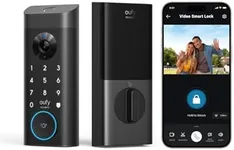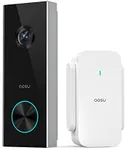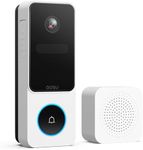Buying Guide for the Best Doorbell Cameras
Choosing the right doorbell camera can make your home safer and more convenient. The best approach is to think about your specific needs: do you want to see who’s at your door from anywhere, record visitors, or talk to them remotely? Consider where you’ll install the camera, how you’ll use it day-to-day, and what features matter most for your home. Understanding the key specifications will help you make a smart choice that fits your lifestyle.Video ResolutionVideo resolution refers to how clear and detailed the video footage from your doorbell camera will be. Higher resolution means sharper images, making it easier to recognize faces or read small details. Common resolutions include 720p (HD), 1080p (Full HD), and 2K or higher. If you just want to see who’s at the door, 720p may be enough, but for clearer images and better security, 1080p or higher is recommended. Choose a resolution that matches how much detail you want to see and how much storage or internet bandwidth you have available.
Field of ViewField of view describes how wide an area the camera can capture. A wider field of view lets you see more of your porch or entryway, which can be helpful for spotting packages or multiple visitors. Typical values range from about 90 degrees to 180 degrees. If your doorway is narrow, a smaller field of view may be fine, but for wide porches or to cover more area, look for a camera with a larger field of view.
Power SourceDoorbell cameras can be powered by batteries, hardwired to your existing doorbell wiring, or plugged into an outlet. Battery-powered models are easier to install and can go almost anywhere, but need recharging or battery changes. Hardwired models don’t need battery changes but require existing wiring and a bit more installation effort. Choose the power source that matches your home setup and how much maintenance you’re willing to do.
Two-Way AudioTwo-way audio lets you talk to visitors through the doorbell camera using your phone or smart device. This is useful for giving instructions to delivery people or talking to guests when you’re not home. Most modern doorbell cameras have this feature, but check the quality of the audio and whether it meets your needs for clear communication.
Night VisionNight vision allows the camera to capture clear video even in low light or darkness. This is important for security at night or in shaded areas. Some cameras use infrared LEDs for black-and-white night vision, while others offer color night vision. If you want to see details after dark, look for a camera with strong night vision capabilities.
Motion DetectionMotion detection means the camera can alert you when it senses movement near your door. Some cameras let you adjust the sensitivity or set specific zones to avoid false alarms from passing cars or animals. If you want to be notified only when someone approaches your door, look for customizable motion detection features.
Storage OptionsStorage options determine how your video footage is saved. Some cameras store video in the cloud, while others use local storage like a memory card. Cloud storage often requires a subscription but lets you access footage from anywhere. Local storage can be more private and may not have ongoing fees. Think about how you want to access your recordings and whether you’re comfortable with cloud services or prefer local storage.
Smart Home IntegrationSmart home integration means the doorbell camera can work with other devices like smart speakers, displays, or security systems. This can make it easier to see who’s at the door or control the camera with your voice. If you already use smart home devices, check that the doorbell camera is compatible with your system.
Weather ResistanceWeather resistance tells you how well the camera can handle rain, snow, heat, or cold. Look for cameras rated for outdoor use, especially if you live in an area with extreme weather. A weather-resistant camera will last longer and work reliably in all conditions.



















